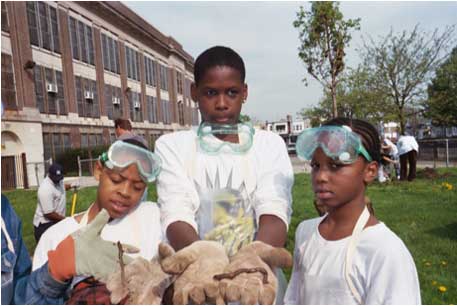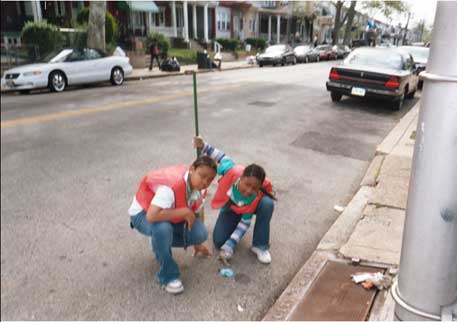February 2006 // Volume 44 // Number 1 // Ideas at Work // 1IAW1
Incorporating Service Learning and Extension in Inner City Middle Schools: A Model for Future Programming
Abstract
The article describes a program model used to promote
science-based learning through a service learning model in an inner city
school. Through working collaboratively with Extension staff, a program was
created to meet the growing academic and social needs of youth in the inner
city school system. If greater emphasis is placed on programming efforts
among Extension, the community, and public schools, successful programs can
be created to enhance the learning of the inner city youth population.
Introduction
When we think of Extension and young people, we are inclined to think of the motto, "learning by doing." This mantra has guided hundreds of youth to grow and develop into successful individuals. It has helped youth to become active and productive citizens in their communities through engaging projects and experiences.
While these are of importance, often we overlook the use of Extension programs as a way to enhance classroom academics and curricula. The skills and content learned in the classroom are often not taught in engaging ways. Many times, youth learn about concepts and ideas through book examples rather than real-life experiences. Extension is in a prime position to assist the learning experiences of youth through hands-on learning, just as the motto, "learning by doing" reflects (Bourdeau, 2004; Hairston, 2004).
This article discusses how a service learning based program has begun to enhance a school science program in a Philadelphia middle school. Through the collaborative efforts of school officials, Extension personnel, and community partners, students have begun to show an improvement in grades in traditional science classes and a love for learning. As youth learn about science, they are simultaneously becoming environmental stewards within their local school and community.
Integrated Pest Management and Science Education
The idea of bringing together a science-based program to meet the needs of middle school students came about from a number of conversations with youth development faculty, integrated pest management (IPM) faculty, and Philadelphia school district personnel. The program was designed to develop a school-based program that would teach 5th and 8th graders about the basic tenets of IPM through service learning activities. Using this approach creates a learning environment for youth to solve ecological problems by using their own community as the classroom. Youth begin to identify different organisms, investigate details more closely, and engage in experiments in their own backyards. Intertwining IPM methods with service learning begins to create a natural fit for engagement and relevant learning.
The premise of service learning allows students to blend academic curriculum with real-life experiences in their own community. Youth not only learn, but use information to address critical issues that are of importance to them and the greater community. This active learning lead the individuals involved in forming this program to create a meaningful and useful partnership that followed the format of:
-
Teaching middle school youth about IPM practices,
-
Providing students with hands on experiences within the school setting and within their own communities,
-
Creating environmental stewards within the community,
-
Teaching young people to have a greater appreciation for their home and school environment, and
-
Encouraging parent involvement in school and community activities.
These lofty goals required several community partners, one of which was Pennsylvania State Cooperative Extension.
The Voice of Extension
Individuals from Extension had the expertise of working with youth on experiential activities and bringing together community partners into the school system in inner city Philadelphia. This knowledge base was quite useful in the formation of the service learning IPM school based program because students needed to not only be connected within their school, but also have a connection to their communities. The Extension staff worked with the Philadelphia-based IPM coordinator, two teachers, and the service learning researcher from Penn State to devise a program that would fit within the overall goals of IPM learning and environmental stewardship. This plan included:
-
Training City Year Corp members (a branch of AmeriCorps dedicated to building stronger democratic communities through leadership, service, and civic engagement with youth ages 17-24) to become 4-H volunteers who would work with selected science classes one day a week on the 4-H Pest Patrol curriculum and the 4-H Public Adventures citizenship-based curriculum;
-
Enrolling the youth in the 4-H program; and
-
Including community partners into the scheduled service learning activities. All the partners thought this would help to increase parental involvement and assist student development in the areas of public speaking, decision making skills, and civic responsibility.
Throughout the year, the students worked with the Extension staff in an in-school program for 1 hour. The student-led program included interactive and civically engaged activities done within the school and the surrounding community. In order to focus on true community needs, students created a survey for the school and greater community to identify three program areas that they wanted to address and then developed supportive activities that would create awareness and behavior change.
The service learning activities included the creation of IPM posters for school hallways and classes, delivering morning announcements on littering and recycling, conducting in-school demonstrations on IPM techniques, and coordinating an informative meeting with lunch room staff on pest related issues. Students worked with community members through several IPM events sponsored by the PA IPM Program and the Entomology Department at Penn State. They made presentations at the local community health fair, sat on the local school Healthy School Board, worked with the janitorial staff for the school district to identify and monitor school pests, and conducted a community walk-through with a local business woman who owned a pest management company.
Assessments were collected through various measures throughout the program. Students reflected on their experiences through journal entries and open discussions on a weekly basis. Content knowledge was assessed through a state based IPM evaluation created for middle school youth. Students were also given the Service Learning Assessment Measure (Webster & Worrell, 2005) to examine their learning and connection to adults and the community. Based on the program objectives, results showed that students gained a greater appreciation of their community and school, had a deeper connection to their school, and enjoyed developing culturally relevant programs for their community.
Benefits
The IPM service learning project has proven extremely beneficial for everyone involved--the youth, their community, and Extension.
Youth
-
Youth have a greater understanding of integrated pest management and its role in the environment through their participation in classroom activities such as creating classroom and school gardens, developing IPM morning announcements, starting an urban recycling program.
-
Youth have seen tangible results of good stewardship as a result of their own work in their own communities (service learning) by participating in a storm drainage clearing program and volunteering at the Neighborhood Health Day, and the BugMobile Day (Figures 1 and 2).
-
Youth have learned that they can make a difference within their own communities through school and community activities.
Figure 1.
Youth Working at a Demonstration Booth at the Shaw Middle School Health
Day

Figure 2.
Youth Participating in a Weekend Storm Drainage Clearing Activity

Community
-
Adults have been able to work with youth in positive and engaging activities.
-
Adults have shared their experiences and expertise with youth on environmental issues.
-
Adults have begun to understand the scope of Extension in the urban community.
Extension
-
There has been increased enrollment urban youth in Extension programs.
-
Extension has had a greater presence in the public school system
Conclusion
If positioned correctly, Extension has the potential of being a significant presence in urban communities. The Extension-urban community connection can be fostered through school partnerships that involve the family and the greater community. These types of programs can lead to greater participation of youth and families in Extension activities and a better understanding of the role of Extension within urban communities.
References
Bourdeau, V. (2004). 4-H experiential education--A model for 4-H science as inquiry. Journal of Extension [Online], 42(5). Available at: http://www.joe.org/joe/2004october/tt3.shtml
Hairston, J. (2004). Identifying what 4-H'ers learn from community service learning projects. Journal of Extension [Online], 42(1). Available at: http://www.joe.org/joe/2004february/rb4.shtml
Worrell, F., & Webster, N. (2005). Academically talented students' attitudes toward service learning. Manuscript submitted for publication.
